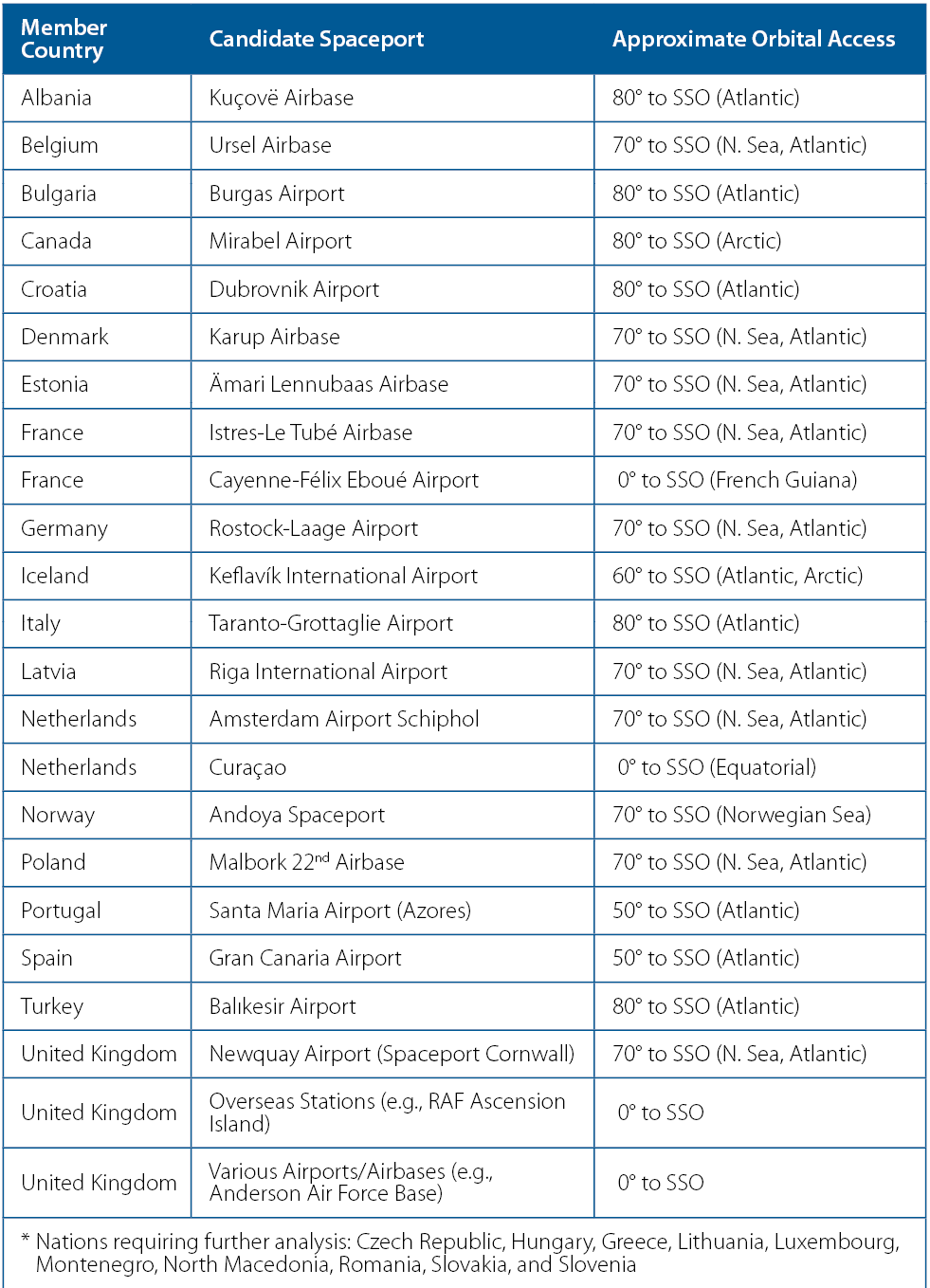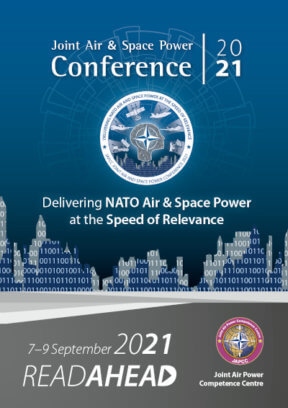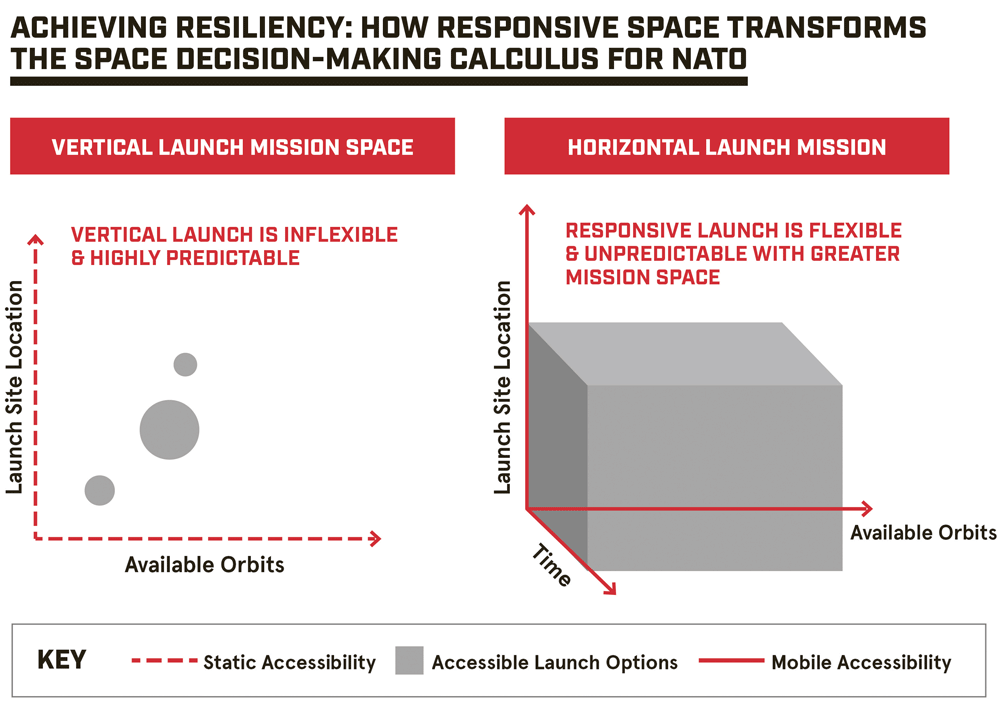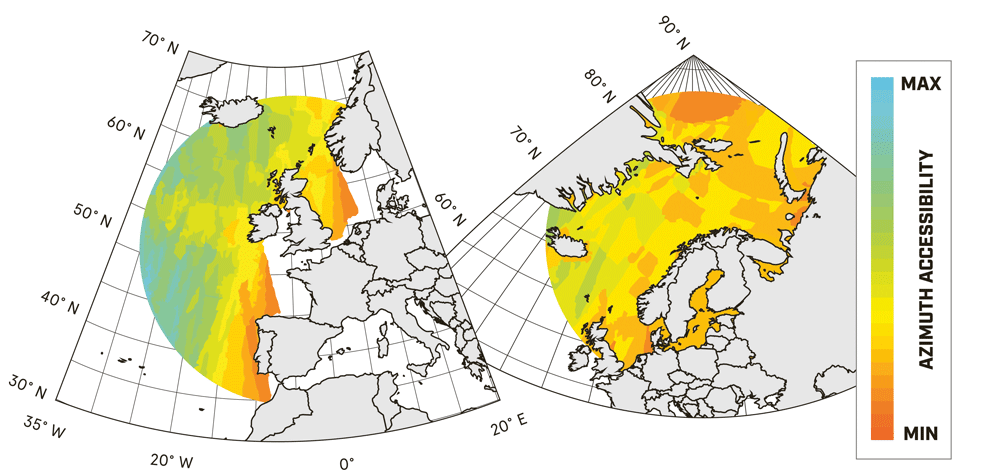Introduction
As NATO’s reliance on Space-based Data, Products, and Services (DPS) grows, NATO member countries face a more contested Space domain with new kinetic and non-kinetic threats. While Space becomes increasingly contested, Space technology is simultaneously advancing with the proliferation of small satellites that are easily reconstitutable. The ability to affordably and responsively replace small satellite constellations will serve as a strong deterrent to adversaries, thanks to the ease and speed by which disabled capabilities can be restored. As then-Chief Marshall of the United Kingdom (UK) Royal Air Force (RAF) Sir Stephen Hiller explained in 2018, ‘The prospect of costeffective constellations of small satellites being built, launched, and replaced quickly is hugely exciting, providing us with the resilience that we seek.’1
This capability, known as Responsive Space, yields tactical and strategic benefits that can enhance NATO’s access to Space-based DPS capabilities. Tactically, Responsive Space enables the rapid establishment of technologies in orbit, rapid reconstitution of disabled assets, rapid deployment of new constellations, and obscuring launch activities from adversaries. Strategically, Responsive Space alters decision-making in Space warfighting, and can enable resilience for NATO Space-based DPS assets. A key requirement for Responsive Space is having a launch capability that can be rapidly mobilized to offer operators with greater control over the launch origin, with sufficient performance to provide a high degree of launch windows and orbits. Such flexibility is only truly offered by an air-launch system in contrast to existing, fixed-infrastructure launch systems.
This paper will introduce how NATO member countries can employ disaggregated small satellite architectures underpinned by Responsive Space to preserve Space-based DPS capabilities. The benefits of achieving Responsive Space and how they can be enabled via horizontal air-launch will be explored. Finally, this paper will examine how NATO member countries can achieve a Responsive Space capability using a global network of allied spaceports.
Employing Reconstitutable Small Satellite Constellations for NATO Space-Based DPS
NATO’s declaration of Space as an operational domain occurred during a unique time in which Space technology is simultaneously advancing with the advent of capable small satellites that are relatively inexpensive compared to traditional monolithic platforms. The United States (US), UK, France, Norway, the Netherlands, Luxembourg, and other NATO member countries are all exploring small satellite applications for various Spacebased DPS missions. Blackjack, BRIK-II, ARTEMIS, and other initiatives exemplify how NATO member countries with established and emerging Space capabilities can enhance access to Space-based DPS via small satellites. As explained by US Air Force General John Hyten, disaggregation of ‘juicy targets’ into distributed networks of satellites can help achieve Space resiliency.2
NATO member countries can further maximize the mission impact of small satellites by deploying them into tailored non-traditional orbits now easily accessible via newly-developed dedicated launch systems. Deploying small satellites into novel orbits across multiple orbital planes enables more frequent revisit and enhanced coverage over an area of interest. For example, a constellation of eight small satellites deployed into eight orbital planes at a critically inclined ‘Magic Orbit’ can provide coverage over an area of interest for 87% of the day, unlocking a meaningful disaggregated and resilient communications or Positioning, Navigation, and Timing (PNT) capability.3
An increase in constellation deployments by NATO member countries to provide more Space-based DPS will create more demand for responsive launch capabilities to enable satellite replenishment. Rapid reconstitution reduces the need to keep spare satellites on orbit, minimizes gaps in coverage when satellite capabilities degrade, and allows refresh of technology in a much quicker timeframe. As detailed in the US Space Force’s Spacepower doctrine, ‘during conflict, Space launch must be dynamic and responsive, providing the ability to augment or reconstitute capability gaps from multiple locations’.4
The Benefits of Responsive Space for Enabling Resiliency
Responsive Space yields a broad set of tactical and strategic benefits that can enhance the activities of NATO member countries in Space and enable resilience. One unique tactical benefit of Responsive Space is the ability to rapidly deploy a new system. A mobile air-launch system can be deployed from a myriad of existing airports regardless of current system deployment locations and mobilized to rapidly launch a constellation of new satellites. Access to these multiple horizontal launch sites can provide NATO member countries with the ability to inject the satellite directly into its orbit to minimize the time in between launch and a satellite constellation’s collection over a target. When coupled with a network of spaceports within different NATO countries, multiple viable pathways to orbit exist and can be quickly activated.
Another tactical benefit of a disaggregated horizontal air-launch system is the ability to provide multiple mission origination locations that can hinder adversarial response to the deployment of new Space capabilities. For example, via loitering or switching among different potential release zones, an air-launch platform provides thousands of daily launch solutions when compared to vulnerable fixed-site launch infrastructure. Thousands of different origination points with little downrange land overflight can be pre-planned and executed at will as part of any mission scenario, offering a flexible launch capability that can deter or delay an adversarial response.
These tactical benefits roll up into a broader strategic impact that expands the Space decision-making landscape. Traditionally, Space warfighting operations have been dictated by the long lead times and the predictability of Space activities – operations in Space require known sequential dependencies that are defined by the laws of physics and orbital mechanics that cannot be disobeyed. Horizontal launch transforms this dynamic as it allows for planners to add far more situational variables, such as access to orbit from numerous launch sites and a reduced timeline to execute. This ability provides NATO member countries an increased set of Space effects that can be implemented to control the Space domain.
Figure 1: Horizontal Launch Mission Space vs Vertical Launch Mission Space.With these benefits, Responsive Space unlocks strategic deterrence and resiliency in space for NATO allies. Deterrence is an effect that both enables and benefits from resiliency in the Space domain. With Responsive Space, adversaries will recognize that pursuing hostile activities in Space will not yield the desired end-state without increasing their exposure to costly retaliation.
Responsive Space Facilitated by NATO European Horizontal Launch Infrastructure
Air-launched systems are now authoritatively proven to be deployed responsively from austere locations around the world with minimal infrastructure.5 Horizontal launch operations can be implemented rapidly to bring orbital access to nearly any NATO member country at any airport near a coastline with a sufficiently long runway. Typical air-launch operations generally require a concrete apron large enough to accommodate the carrier aircraft that is displaced from heavy traffic or other airport personnel. Most international commercial airports or government airbases can accommodate such a need.
Spaceport feasibility analytical tools show that horizontal launch from NATO member countries would enable turnkey domestic launch activities with a great degree of orbital access to many inclinations.6 A region extending to the north and west of continental Europe was analyzed while assessing launches to inclinations ranging between 60° and Sun-Synchronous Orbit (SSO); lower inclinations are possible with increased rocket reliability or extended aircraft range. Northern and southern departure azimuths were considered, resulting in tens of thousands of simulated and evaluated air-launch trajectories. These trajectories were then evaluated for acceptably low risk in casualty expectation to populations they overflew using US Federal Aviation Administration (FAA) risk models.
Figure 2: NATO European Region Inclination Access via Horizontal Air-launch.Figure 2 shows an azimuth access rating map that adheres to a casualty expectation lower than the maximum allowable conditional ‘Expected Casualty’ of 1 x 10-4 by the FAA for launch licensing in regulating allowable launch activities; the Expected Casualty is a calculation that aggregates risk to the uninvolved public downrange of the rocket launch from impacting vehicle in the event of an anomaly. Regions with most favourable access between 60° and SSO are indicated by the colour bar. Blue regions indicate the ability to launch to all inclinations in the considered range, while orange and red indicate launch is possible to fewer inclinations.
Figure 3 depicts examples of orbital access corridors showing launch envelopes to inclinations between 70° and SSO from the North Sea, and 80° and SSO from the Atlantic Ocean. Lower inclinations can be reached by reaching release sites further from shore. These regions are readily accessible to most NATO member countries, and the access is further enhanced by potential launch from overseas territories and bases.
Figure 3: Horizontal Air-Launch Orbital Access Corridors near NATO European Member Nations.

Table 1 provides a preliminary list of most of the NATO member countries that have existing airports in proximity to these regions. Some NATO member countries have more than one potential airbase or can utilize overseas territories to expand their orbital access. Such examples are the Portuguese Azores, French Guiana, Dutch Curaçao, and various UK overseas stations (Ascension, Diego Garcia). When envisioning a disaggregated network of spaceports capable of rapid or simultaneous air-launch activities, it has been shown that powerful small satellite constellations can be constructed within days or less.7 Such a framework would involve two or more NATO launch carrier aircraft and their associated mobile support equipment, stationed among any combination of compatible spaceports. The result is a disaggregated and unpredictable launch network that can be activated at a moment’s notice.
Conclusion
Given the discussed advancements in small satellite technologies and prospective horizontal launch infrastructure, NATO member countries are in a unique position to capitalize on these developments to build out a resilient Space architecture for existing future Space-based DPS. NATO member countries can pool resources to leverage their respective domestic industrial capabilities, collaboratively building out this global Space ecosystem. NATO member countries could begin doing so by formally assessing which airports (including those in Table 1) could be configured to accommodate a horizontal launch capability and studying the CONOPs for joint responsive launch operations out of these sites. Existing multilateral initiatives such as the Responsive Space Capabilities Memorandum of Understanding, already signed by seven NATO member countries, serve as an example of how this can be done.8 Ultimately, this growing international interest in Responsive Space creates an opportunity for NATO member countries to develop architectures that leverage shared allied investments in this capability.














